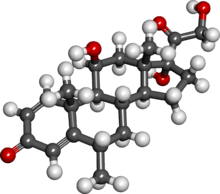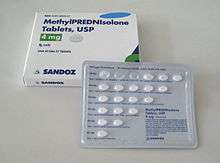Methylprednisolone
 | |
 | |
| Clinical data | |
|---|---|
| Trade names | Medrol, Meprolone |
| AHFS/Drugs.com | Monograph |
| MedlinePlus | a682795 |
| License data | |
| Pregnancy category | |
| Routes of administration | IV, IM, IV Infusion, Oral, Rectal, Topical |
| ATC code | D07AA01 (WHO) D07AC14 (WHO), D10AA02 (WHO), H02AB04 (WHO) |
| Legal status | |
| Legal status | |
| Pharmacokinetic data | |
| Protein binding | 78% |
| Metabolism | liver primarily, kidney, tissues; CYP450: 3A4 substrate |
| Biological half-life | urine; Half-life: 18-26h (biological) |
| Identifiers | |
| |
| Synonyms | (6α, 11β)-11,17,21-trihydroxy-6-methyl-pregna-1,4-diene-3,20-dione |
| CAS Number |
83-43-2 |
| PubChem (CID) | 6741 |
| IUPHAR/BPS | 7088 |
| DrugBank |
DB00959 |
| ChemSpider |
6485 |
| UNII |
X4W7ZR7023 |
| KEGG |
D00407 |
| ChEBI |
CHEBI:6888 |
| ChEMBL |
CHEMBL650 |
| ECHA InfoCard | 100.001.343 |
| Chemical and physical data | |
| Formula | C22H30O5 |
| Molar mass | 374.471 g/mol |
| 3D model (Jmol) | Interactive image |
| |
| |
| (verify) | |
Methylprednisolone is a synthetic glucocorticoid or corticosteroid drug. It is marketed in the USA and Canada under the brand names Medrol and Solu-Medrol.[1] It is also available as a generic drug.
It is a variant of prednisolone, methylated at carbon 6 of the B ring.
It is on the WHO Model List of Essential Medicines, the most important medications needed in a basic health system.[2]
Medical uses
Like most adrenocortical steroids, methylprednisolone is typically used for its anti-inflammatory effects. However, glucocorticoids have a wide range of effects, including changes to metabolism and immune responses. The list of medical conditions for which methylprednisolone is prescribed is rather long, and is similar to other corticosteroids such as prednisolone. Common uses include arthritis therapy and short-term treatment of bronchial inflammation or acute bronchitis due to various respiratory diseases. It is used both in the treatment of acute periods and long-term management of autoimmune diseases, most notably systemic lupus erythematosus. It is also used as a treatment for multiple sclerosis.
Another potential use of methylprednisolone is for vestibular neuritis.[3]
After egg retrieval for a cycle of in vitro fertilization, methylprednisolone may be prescribed to prevent the body from rejecting the embryos being transferred, up to the time of implantation.[4][5]
Side effects
Long-term use of methylprednisolone, as with all corticosteroids, can be associated with hyperglycemia, decreased resistance to infection, swelling of face, weight gain, congestive cardiac insufficiency, fluid and sodium retention, edema, hypertension, increased eye pressure, glaucoma, osteoporosis, and psychosis, especially when used at high doses.[6][7] The most serious side effect occurs after the adrenal glands cease natural production of cortisol, which methylprednisolone will replace. Abrupt cessation of the drug after this occurs can result in a condition known as Addisonian crisis, which can be fatal. To prevent this, the drug is usually prescribed with a tapering dose, including a predosed "dose pack" detailing a specific number of tablets to take at designated times over a several-day period. Pharmacists sometimes advise that this drug may cause sleeplessness and "down" moods.
Individuals on methylprednisolone therapy should assiduously avoid exposure to measles and chicken pox, as contracting these viral infections while on high-dose corticosteroids can result in a potentially fatal viral course. Any accidental exposure to these viral infections by individuals uncertain of their immunity to chicken pox or measles should be reported immediately as prophylactic immunoglobulin therapy may be administered. Additionally, the administration of live, attenuated vaccines is contraindicated for individuals taking immunosuppressive doses of methylprednisolone. The exception to this rule is patients receiving complete corticosteroid replacement therapy, e.g., for Addison's disease, who may follow standard immunization protocols.

.jpg)
Mechanism of action
Unbound glucocorticoids cross cell membranes and bind with high affinity to specific cytoplasmic receptors, modifying transcription and protein synthesis. By this mechanism, glucocorticoids can inhibit leukocyte infiltration at the site of inflammation, interfere with mediators of inflammatory response, and suppress humoral immune responses. The anti-inflammatory actions of corticosteroids are thought to involve phospholipase A2 inhibitory proteins, lipocortins, which control the biosynthesis of potent mediators of inflammation such as prostaglandins and leukotrienes.
See also
References
- ↑ Methylprednisolone - Compound Summary PubChem
- ↑ "19th WHO Model List of Essential Medicines (April 2015)" (PDF). WHO. April 2015. Retrieved May 10, 2015.
- ↑ Strupp M, Zingler VC, Arbusow V, Niklas D, Maag KP, Dieterich M, Bense S, Theil D, Jahn K, Brandt T (July 2004). "Methylprednisolone, valacyclovir, or the combination for vestibular neuritis" (PDF). N. Engl. J. Med. 351 (4): 354–61. doi:10.1056/NEJMoa033280. PMID 15269315.
- ↑ "Medications Commonly Used During the IVF Cycle". Continuum Reproductive Center. Retrieved 14 June 2013.
- ↑ "In Vitro Fertilization (IVF)". Reproductive Medicine Associates of Michigan. Retrieved 14 June 2013.
- ↑ "SOLU-MEDROL (methylprednisolone sodium succinate) injection, powder, for solution". National Institutes of Health. Retrieved 24 August 2012.
- ↑ "Medrol (Methylprednisolone - Tablets by Pfizer)". Sfatul Medicului. Retrieved 14 April 2013.
External links
- Medrol Prescribing Information Pfizer
- U.S. National Library of Medicine: Drug Information Portal - Methylprednisolone
- "methylprednisolone" at medicinenet.com